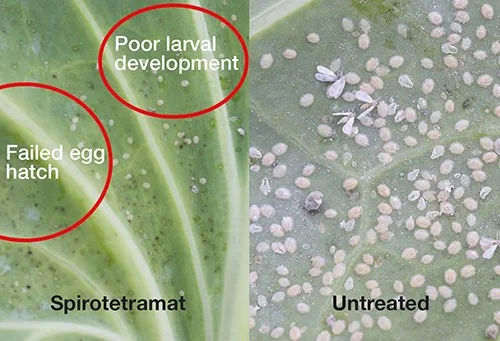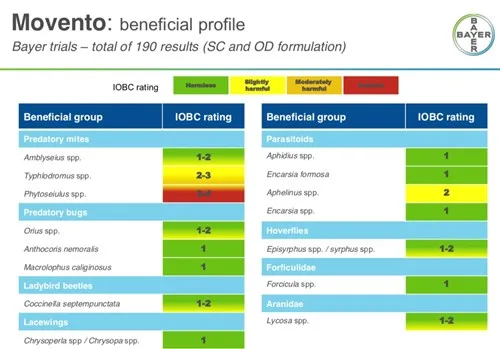

Movento
A ketoenol insecticide for the control of a range of insect pests in outdoor crops of Brussels sprouts, broccoli/ calabrese, cabbage, cauliflower, collards, kale, lettuce, potatoes, onions and more.
Product details
A ketoenol insecticide for the control of a rang
e of insect pests in outdoor crops of Brussels sprouts, broccoli/ calabrese, cabbage, cauliflower, collards, kale, lettuce, potatoes, onions, carrots, swede, turnip and parsnip.
Product Profile
Important Information
Restrictions
Avoid spraying within 5m of the field boundary to reduce effects on non-target insects or other arthropods.
All potato varieties may be treated but if the crop is intended for processing consult the processor before the use of Movento. Applications to potato varieties that produce flowers can only be made from the end of flowering (BBCH 69).
Protects the whole plant
Provides lasting control
Broad spectrum sucking pest control
Safe to beneficials for excellent IPM
No cross resistance
Spirotetramat, the active substance in Movento, offers a unique combination of attributes.
Protects the whole plant: two-way systemicity
Most systemic insecticides are transported in the xylem only – outwards and upwards from the point of application: they are one-way systemic.
Spirotetramat is additionally transported in the phloem, and so can move back down into the plant to the roots and towards new growth; this makes it two-way systemic. This delivers unrivalled protection to new growth while improving control of those hard-to-target sucking pests.

As a result, Movento not only controls hidden and hard-to-target pests but delivers unrivalled protection of new growth. Sucking pests merely have to ingest spirotetramat while actively feeding to ensure control.
After being sprayed on the leaf, inactive spirotetramat is converted to spirotetramat cis-enol, which is active and highly mobile in xylem and phloem.

Gives thorough, lasting control: lifecycle disruption
Movento’s mode of action breaks the lifecycle and is therefore highly effective in reducing pest populations and avoiding bounce-back.
Insects rely heavily on lipids (fats and similar substances) for their metabolic needs, particularly to aid reproduction, embryogenesis (formation and development of young), metamorphosis and moulting (moving from one growth stage to another) and flight.
Spirotetramat inhibits acetyl CoA carboxylase (ACC-ase), which in turn inhibits lipid biosynthesis. This offers very powerful opportunities for control. Young insects cannot mature, leading to lack of fecundity and fertility. Eggs fail to hatch. Larvae fail to develop. Moults are incomplete. Adult females accumulate nymphs and die.

Timing application – all crops
Due to its mode of action, rapid knockdown of pests should not be expected. Obvious control usually occurs after 3–7 days and is dependent upon pest stage, with youngest larvae being most susceptible and adults least susceptible. For optimum control, application should be made as soon as pests appear in the crop, so that population build up is prevented through targeting the young larval stages as they are produced.
Through its two-way systemicity, the active ingredient spirotetramat is translocated to growing points and is able to reach hidden pests in heart leaves and on roots. However, it is important to note that there is little movement from new leaves to older leaves, so good spray cover on older leaves will be particularly important.
To get the best from Movento, apply when plants are actively growing, and pests are actively feeding. Avoid application to crops that are not actively growing (e.g. during drought or cold periods) as movement of the active substance and hence efficacy will be impaired.
Rather than putting a cut-off date on the calendar beyond which Movento should not be used, consider the season. In a mild autumn conditions and growth may continue to be suitable into October and November. However, in a cooler, earlier autumn, growth, and pest activity may have slowed to the point of being unsuitable by the end of September.
Brussels sprouts, broccoli/calabrese, cabbage, cauliflower, collards and kale.
For the control of mealy cabbage aphid (Brevicoryne brassicae), peach-potato aphid (Myzus persicae), brassica whitefly (Aleyrodes proletella) and swede midge (Contarinia nasturtii).
Apply Movento as pests start to build up in the crop.
Dose: 0.5 L/ha in 300–600 L water/ha.
Long lasting control from Movento comes from its thoroughness, preventing ‘bounce-back’ of populations. New infestations will need further treatment.
Application is timed best when the crop has ‘thickened up’ and Movento’s unique ability to control hidden aphids is most valuable. Also at this time, increased ground cover will optimise capture of the chemical by the crop.
Good spray cover of infested older leaves is important as they do not benefit much from redistribution which is towards growing points i.e. new/heart leaves, buttons and curd.
Use Movento in programmes planned with consideration of brassica crop type and the focus of control; aphids, whitefly or both.
Programme planning: Focus on aphid control
Where the focus is aphid control use Movento for long lasting protection in dense actively growing crops, when pests are hidden.
When the crop structure is open, and aphids are more easily targeted with a contact spray consider a product with ‘knockdown’ performance such as FLiPPER (fatty acids C7-C20). Apply FLiPPER every 7 days as required by pest pressure but do not apply more than three weekly applications consecutively.
If pressure is higher, a knockdown insecticide belonging to a different mode of action group, such as those containing pyrethrins may offer protection, although these may not be suitable where the targeted pest may be resistant.
Foliar control programmes should start as soon as aphids appear in the crop.
The following diagrams show how these principles can be applied to the planning of aphid control in cabbage when aphid infestation begins at the three true leaf stage. This approach can apply equally to broccoli/calabrese and cauliflower where hidden pests get into the florets and curd. It should also provide effective control of any whitefly present.
Total reliance on one pesticide will hasten the development of resistance; pesticides of different chemical types or alternative control measures should be included in a planned programme. In a spray programme, Movento should be used with other insecticides of a different mode of action, either in alternation or as a 2-spray block within the programme.

ALWAYS READ THE LABEL BEFORE USE.